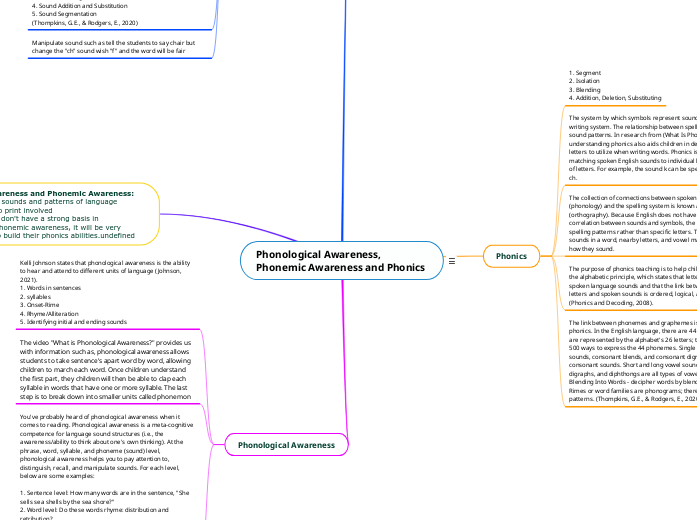Phonological Awareness, Phonemic Awareness and Phonics
Phonics
1. Segment
2. Isolation
3. Blending
4. Addition, Deletion, Substituting
The system by which symbols represent sounds in an alphabet writing system. The relationship between spelling patterns and sound patterns. In research from (What Is Phonics?, 2017), understanding phonics also aids children in determining which letters to utilize when writing words. Phonics is the process of matching spoken English sounds to individual letters or groups of letters. For example, the sound k can be spelled as c, k, ck or ch.
The collection of connections between spoken sounds (phonology) and the spelling system is known as phonics (orthography). Because English does not have a one-to-one correlation between sounds and symbols, the focus is on spelling patterns rather than specific letters. The position of sounds in a word, nearby letters, and vowel markers all affect how they sound.
The purpose of phonics teaching is to help children understand the alphabetic principle, which states that letters represent spoken language sounds and that the link between written letters and spoken sounds is ordered, logical, and predictable (Phonics and Decoding, 2008).
The link between phonemes and graphemes is explained in phonics. In the English language, there are 44 phonemes that are represented by the alphabet's 26 letters; there are over 500 ways to express the 44 phonemes. Single consonant sounds, consonant blends, and consonant digraphs are all consonant sounds. Short and long vowel sounds, vowel digraphs, and diphthongs are all types of vowels.
Blending Into Words - decipher words by blending sounds.
Rimes or word families are phonograms; there are 37 rime patterns. (Thompkins, G.E., & Rodgers, E., 2020)
Phonemic Awareness
Reading rocks states that the capacity to recognize and control individual sounds (phonemes) in spoken words is known as phonemic awareness.
Only the individual sounds of language
Identifying sounds, categorizing sounds in words, substituting sounds, blending sounds, segmenting sounds are what students need to become phonemically aware.
Blending individual sounds into a word or breaking a word down into its individual sounds. Saying the words slow and having the students say it fast.
The University of Oregon Center on Teaching and Learning, 1997 states that, phonemic awareness necessitates that readers pay attention to how letters represent sounds. It prepares readers for reading in print. It instructs readers on how to sound out and read new words. It assists readers in comprehending the alphabetic concept (that the letters in words are systematically represented by sounds).
Teachers encourage phonemic awareness in their students by creating language-rich settings. Phonemic awareness teaching should be age-appropriate, well-planned, and well-integrated into a comprehensive reading curriculum. The following are some examples of instructional strategies:
1. Sound Matching
2. Sound Isolation
3. Sound Blending
4. Sound Addition and Substitution
5. Sound Segmentation
(Thompkins, G.E., & Rodgers, E., 2020)
Manipulate sound such as tell the students to say chair but change the "ch" sound wish "f" and the word will be fair
Phonological awareness and Phonemic Awareness:
1. Able to hear the sounds and patterns of language
2. Auditory only, no print involved
3. If your students don't have a strong basis in phonological and phonemic awareness, it will be very difficult for them to build their phonics abilities.
Phonological Awareness
Kelli Johnson states that phonological awareness is the ability to hear and attend to different units of language (Johnson, 2021).
1. Words in sentences
2. syllables
3. Onset-Rime
4. Rhyme/Alliteration
5. Identifying initial and ending sounds
The video "What is Phonological Awareness?" provides us with information such as, phonological awareness allows students to take sentence's apart word by word, allowing children to march each word. Once children understand the first part, they children will then be able to clap each syllable in words that have one or more syllable. The last step is to break down into smaller units called phonemon
You've probably heard of phonological awareness when it comes to reading. Phonological awareness is a meta-cognitive competence for language sound structures (i.e., the awareness/ability to think about one's own thinking). At the phrase, word, syllable, and phoneme (sound) level, phonological awareness helps you to pay attention to, distinguish, recall, and manipulate sounds. For each level, below are some examples:
1. Sentence level: How many words are in the sentence, "She sells sea shells by the sea shore?"
2. Word level: Do these words rhyme: distribution and retribution?
3. Syllable level: What is the last syllable in the word "discrimination?"
4. Phoneme level: What is the final sound in photo?
(Stanovich, K. 1994)
